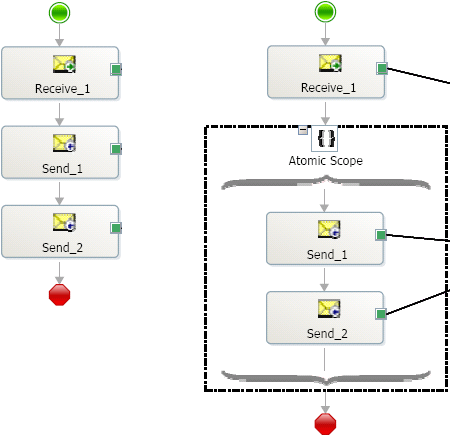Persistence in Orchestrations
The orchestration engine saves the entire state of an orchestration instance at various persistence points to allow rehydration of the orchestration instance. The state includes any .NET-based components that may be used in the orchestration, in addition to messages and variables. The engine stores state at the following persistence points:
End of a transactional scope (atomic or long running)
At debugging breakpoints
At the execution of other orchestrations through the Start Orchestration shape
At the Send shape (except in an atomic transaction)
When an Orchestration Instance is suspended
When the system shutdowns in a controlled manner
When the engine determines it wants to dehydrate
When an orchestration instance is finished
The engine optimizes the number of persistence points as they are expensive, especially when dealing with large message sizes. As shown in the two orchestration instances below, in the orchestration with the Send Shapes in an atomic scope, the engine determines a single persistence point between the end of the transaction scope and the end of the orchestration. In the other orchestration, there will be two persistence points, one for the first Send shape and the second for the Send shape plus end of the orchestration.
Orchestration persistence

Any .NET-based objects you use in orchestrations, either directly or indirectly, must be marked as serializable unless they are invoked in atomic scopes, or if the objects are stateless and are invoked only through static methods. System.Xml.XmlDocument is a special case and does not need to be marked as serializable regardless of the transaction property for a scope.
How does the special handling for System.Xml.XmlDocument work:
When the user defines a variable X of type T, where T is System.Xml.XmlDocument or a class derived from System.Xml.XmlDocument then the compiler will treat X as a serializable object.
When serializing X, the runtime will keep the following pieces of information: (a) the actual type Tr of the object X is referring to (b) the OuterXml string of the document.
When de-serializing X, the runtime will create an instance of Tr (this assumes a constructor that does not take any parameters) and will call LoadXml providing the instance with the saved OuterXml. X will then be set to point to the newly created instance of Tr.